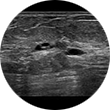
What is Breast Ultrasound?
Ultrasound uses sound waves to produce images of internal organs and body tissue. Breast ultrasound is an imaging procedure that is not routinely used for screening, but it can be useful for evaluating some breast abnormalities identified by mammography. There is no radiation involved.
Why is Breast Ultrasound Performed?
Breast ultrasound is primarily used to help physicians diagnose potential breast abnormalities previously detected by physical examination or mammography. Ultrasound can determine the difference between solid masses in breast tissue and fluid-filled cysts. It can also help determine whether a solid mass is a potentially cancerous tumor or a non-cancerous growth.
Many cancers are not visible on ultrasound and it is not intended to replace routine screening mammography. However, some physicians may recommend breast ultrasound in addition to screening mammography for certain women, such as those with dense breasts.
What to Expect from Ultrasound
In addition to traditional ultrasound, automated breast ultrasound is available at Breastlink of Orange and Breastlink of Temecula Valley.
Traditional Breast Ultrasound
A woman receiving a breast ultrasound will be asked to remove clothing above her waist and she will be positioned on her back on an examination table. Ultrasound gel will be applied to the area of her breast being examined.
The radiology technologist performing the breast ultrasound will move a handheld device, called a transducer, over the examination area. The transducer tracks movements of sound waves through breast tissue and transmits this information to a computer, which renders it visually on a monitor in real time.
Breast ultrasound does not cause pain and takes approximately 30 minutes.
Automated Breast Ultrasound
Automated breast ultrasound works similarly to traditional breast ultrasound. Sound waves are interpreted by a computer and translated into images. During traditional breast ultrasound, a radiologist manually operates an information-gathering device called a transducer.
In automated breast ultrasound, a larger transducer is placed over a woman’s breasts and gathers information automatically. Benefits of automated breast ultrasound include shorter exam times and greater consistency in results.








